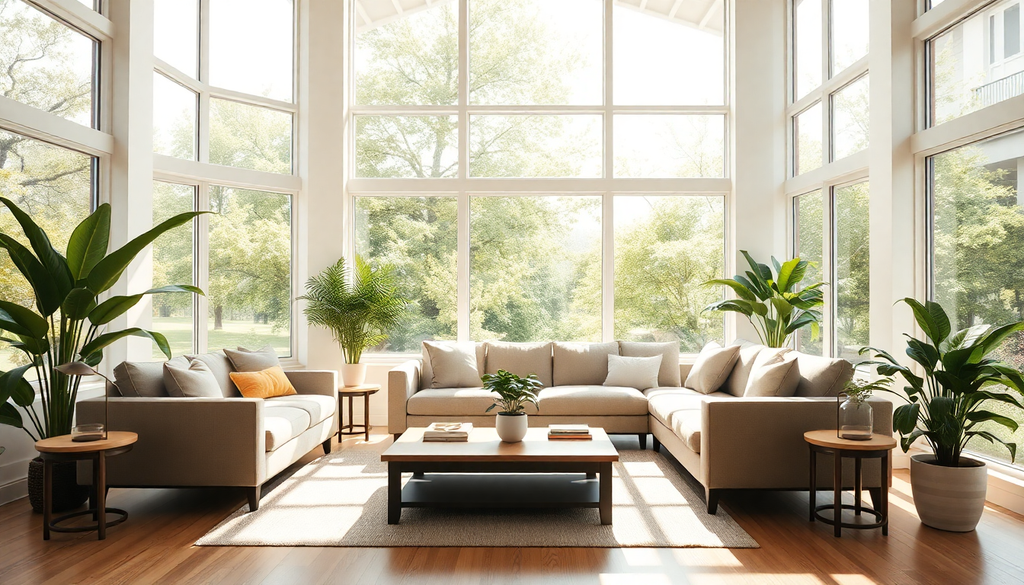Keep furniture away from windows to maximize natural light

The Importance of Unobstructed Natural Light
Blocking windows with furniture doesn’t just limit sunlight—it changes the entire feel of a room. Natural light creates an open, energized space, while dim, shadowed corners can make a home feel smaller and less inviting. Keeping windows clear ensures daylight reaches as much of the room as possible, reducing the need for artificial lighting and cutting down on energy costs.
Science backs this up. Studies show that placing bulky furniture in front of windows can reduce indoor daylight availability by up to 11%. That’s light lost to couches, bookcases, and oversized dressers—not to mention the psychological effects of a darker home. Sunlight has been linked to improved mood, better focus, and even higher productivity. The more of it you let in, the better your space (and your mind) will feel.
Whether for aesthetics, efficiency, or well-being, unobstructed windows are a simple way to make any room brighter, fresher, and more functional. Keep them clear, and let the daylight do its job.
Strategic Furniture Placement for Natural Light
The way you position furniture dictates how well light moves through a space. Keep it simple: if a piece of furniture blocks a window, it's stealing daylight.
- Avoid large, bulky furniture near windows. Sofas, bookcases, and wardrobes act like walls, cutting off natural light and making the room feel darker than it should. Instead, keep windows clear or use compact, low-profile seating.
- Opt for furniture with exposed legs. Sofas, chairs, and tables that sit on visible legs create a sense of openness, allowing sunlight to pass through instead of stopping at a solid base.
- Angle furniture strategically. Instead of placing pieces directly in front of windows, position them at angles to allow daylight to filter into the rest of the room uninterrupted.
- Keep window-adjacent furniture low. Benches, ottomans, and low bookshelves can sit near windows without significantly blocking natural light.
A well-lit space isn’t about doing more—it’s about placing things smarter. Keep windows open, let the light in, and your space transforms without any extra effort.
Using Reflective Surfaces to Enhance Sunlight
Light doesn’t just enter a room—it moves through it. The right surfaces can amplify its reach, making even dim corners come alive.
- Mirrors are your best friend. Position a large mirror directly across from a window to reflect natural light deeper into the space. This trick works especially well in smaller rooms, where every bit of daylight counts. If a full-length mirror isn’t an option, multiple smaller mirrors can achieve a similar effect.

- Glass and glossy materials do more than look sleek. A glass coffee table won’t block light the way a solid wood one would. Glossy floors, high-shine countertops, and even lacquered furniture help distribute natural brightness more evenly.
- Walls play a role too. Light-colored walls—especially white, soft gray, or pale pastels—naturally reflect more sunlight than darker shades. A satin or semi-gloss finish further enhances this effect, subtly bouncing light around the room without overwhelming the space.
When used strategically, reflective surfaces turn natural light into a design tool—no extra lamps required.
Additional Tips for Optimizing Natural Light Flow in Rooms
A few minor tweaks can go a long way when it comes to maximizing sunlight indoors. Here are some practical steps to ensure your space stays as bright as possible:
- Clean windows regularly – Dust, grime, and rain streaks cut down on the amount of light coming in. A quick wipe-down every few weeks keeps sunlight streaming in at full force.
- Use lightweight, sheer curtains – Heavy drapes swallow daylight. Swap them out for sheer or linen curtains that diffuse light without blocking it. If privacy is a concern, consider top-down, bottom-up shades.

- Paint eaves white – White eaves reflect more light into your home, pushing sunlight deeper into your rooms. It’s a simple but effective trick, especially for spaces that don’t get direct sun.
- Incorporate skylights or glass doors – If you’re renovating or making changes, consider adding skylights or glass-paneled doors. These features flood interiors with natural light and improve overall brightness.
Maximizing light isn’t just about where you place furniture—it’s about removing obstacles, enhancing reflection, and making the most of what’s available.
Conclusion
Maximizing natural light starts with smart furniture arrangement. A clear path for sunlight means a brighter, more open space—no renovation required. Keep bulky pieces away from windows, use reflective surfaces, and be intentional with furniture placement. The payoff? A home that feels bigger, fresher, and more inviting—all while cutting down on artificial lighting. Small tweaks, big impact. Now, time to move some furniture.

